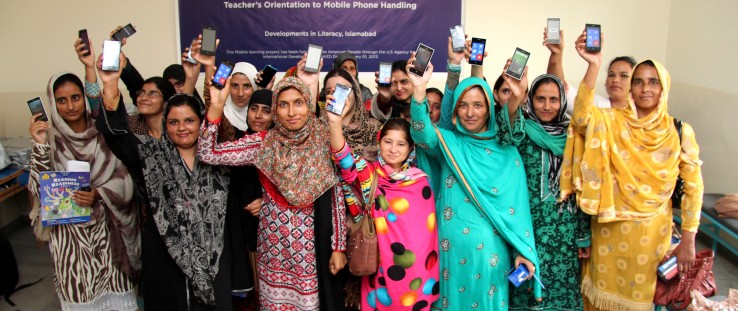 Teachers who participated in the mLearning project continue to access, view and share the learning videos on their smartphones.
USAID
Teachers who participated in the mLearning project continue to access, view and share the learning videos on their smartphones.
USAID
 Teachers who participated in the mLearning project continue to access, view and share the learning videos on their smartphones.
USAID
Teachers who participated in the mLearning project continue to access, view and share the learning videos on their smartphones.
USAID
In rural Pakistan, most teachers cannot attend continuing education training due to their class schedules, household responsibilities, and cultural and financial constraints. In response, the nonprofit Developments in Literacy (DIL) recently introduced mobile learning, or mLearning, as a way to give teachers easier access to the training and professional development courses they need to better meet the needs of their students.
For Fiza Shah, the CEO of DIL and a Pakistani American, it is her way of giving back.
“Our aim is to provide quality education to the deprived children of Pakistan, especially girls,” she said. “In Pakistan’s small cities and villages, teachers usually do not get the opportunity to receive quality training. The beauty of mobile learning is that the teachers can be in any corner of the country and can watch lessons on their mobile phones that will improve their teaching ability. USAID’s assistance was instrumental to the success of this project.”
The USAID-supported program ran from January 2013 to November 2014. Established by Pakistani Americans in 1997, DIL focuses on improving education in Pakistan’s underdeveloped areas. The organization currently operates and manages 123 schools dedicated to providing quality education to disadvantaged children.
To address gaps in teacher knowledge and training, DIL provided teachers with smartphones and established 23 Wi-Fi hubs across the country where they could gather once a month to download new lesson plans. The 300 different lessons consisted of 8- to 10-minute instructional videos on teaching math and English in an enriching and engaging way.
The project was designed on the premise that teachers who have a strong command over the content they teach are more effective in the classroom. mLearning technology is already in use in other countries such as neighboring India and sub-Saharan Africa’s Kenya and Senegal.
For Maria Memon, a DIL teacher in Khairpur, Sindh, one of the least educated areas in the country, this proved to be a game changer. Memon is one of the 200 teachers at DIL schools who take part in the mLearning program.
“Before, it was very challenging,” she says. “We used to get frustrated but were helpless. Now, whenever we want, we can look at a teaching aid video on our mobiles and better understand the concepts. Whenever I teach a new lesson or plan for it, I watch the teaching aid video on my mobile. I can pause the video and prepare my notes for the class. It also has a dictionary and I can easily find the meaning of a new word if I don’t know it. My own phonics has also improved a lot. Earlier, my grammar was not very good, but that has also improved considerably.”
For Rabia*, a 12-year-old student in her class, coming to school is now a joyous experience.
“Before, our teacher did not teach us using teaching aids. Now she does, and it’s much more fun,” she says.
Currently, there are still nearly 5 million school-aged children in Pakistan not enrolled in school, which ranks the country among the worst in the world for school attendance. Despite an increase in access to education, nearly half of Pakistani children drop out of school before age 16.
Studies have shown that girls who complete primary education are less likely to get married before 18 or become victims of domestic abuse, and have fewer children. Yet girls in Pakistan drop out at twice the rate of boys, lowering female literacy rates in some areas to a mere 8 percent.
“We work mostly in rural areas where teachers do not have any support mechanisms, and we wanted to reach out to a larger group of teachers with these aids simultaneously,” said Jennifer Bennett, DIL’s executive director. “We thought of using mobiles because almost half of this world’s population now has a basic familiarity with mobile phones. They are accessible and you can easily carry them around. Teachers can revise their tutorials while sitting at home. They can refer to them in the classroom. They can embed these tutorials in their lesson plans.”
In Dir, a conservative and conflict-prone area bordering Afghanistan, mLearning allowed teachers access to essential tools and methodology that they wouldn’t have received without the project. One teacher, Gulnaz, who prefers to be identified only by her first name for security reasons, could not imagine traveling to a big city for teacher training.
“Earlier, I did not have a logical method of introducing new concepts to my students. I relied on the same methodology through which I was taught,” said Gulnaz. “Now I know how to effectively introduce each new concept to the children. I can now keep my class involved for the duration of a lesson through these activities.”
Back in Sindh, Laila Naz Channa faced a different challenge. It took her community some time to adjust to young female teachers having mobile phones. Due to the fear of social stigmatization, their families were reluctant to allow them to use cell phones, which are new to many rural Pakistanis.
“None of the girls in my family ever owned a mobile and still do not,” said Channa, who teaches at a DIL primary school in a small town of Khairpur, Sindh. “When they were giving me the mobile, I was very apprehensive. At home, I showed it to my brother. He went quiet.”
Her family eventually saw the benefits that mobile technology brings, particularly as a teaching aid.
“I started receiving lessons on my phone. My brother, who has a lot of interest in English language, was very impressed. He realized that these mobiles can be an academic aid. They are not for any immoral purpose,” Channa said. “Now I can easily use this mobile at home.”
Today, approximately 5,000 students enrolled at DIL’s schools are benefitting by classes taught by 200 teachers who were provided smartphones to assist with their curricula. With its base in the United States, DIL was well-positioned to have professional educators develop English lesson scripts and embedded assessments based on the latest international trends. The training team in Pakistan made sure the teaching aids were in line with Pakistan’s national targets and the national curriculum.
After studying the lessons, teachers’ subject knowledge increased 30 percent in English and 40 percent in mathematics. More than 90 percent of teachers have reported that the project has positively impacted their teaching. Principals have observed improved classroom instruction, increased student engagement, and spill-over benefits for other teachers and the community.
DIL’s school management staff has also directly benefited from the lessons and has used them to improve their own English. They also report that teachers who participated in the project are continuing to access, view and share the learning videos. Ownership of the mobile devices gives them unlimited access to the learning material for their own mastery and as a planning resource.
Because DIL owns most of the content and can share the lessons freely, the costs to expand the project’s reach are significantly less than the effort’s start-up costs. Since the end of the project, the learning videos have been shared with 40 schools outside the DIL school system as part of a teachers’ resource library. DIL also provided the content on laptops for teachers to use in the classroom at 19 DIL schools.
“In my village, cell phones were considered a frivolous tool. But when we started using them to plan lessons and to access teaching content, people’s perceptions changed,” said Shaista Bashir, a primary school teacher from the suburbs of Islamabad. “I feel proud that I have access to this latest technology.”
*Full name not available.







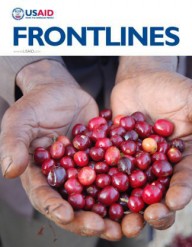

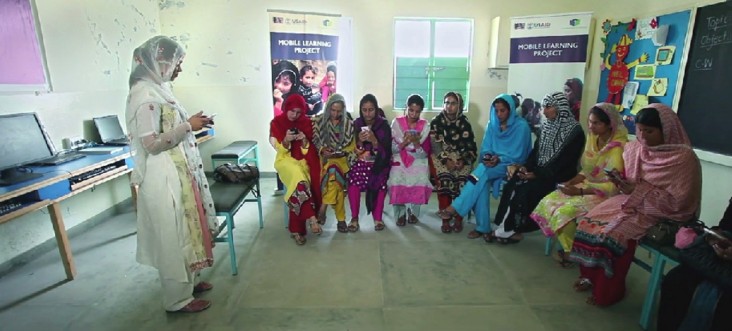
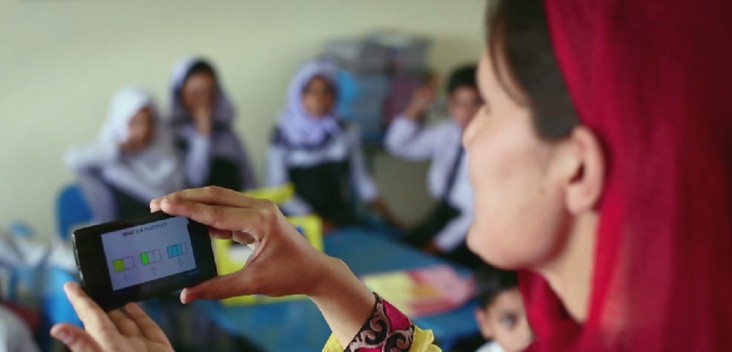
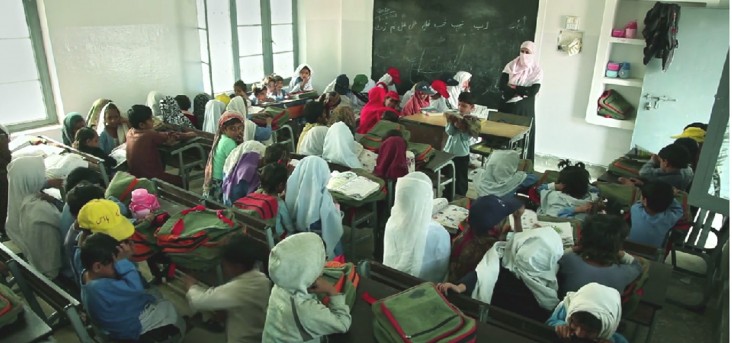
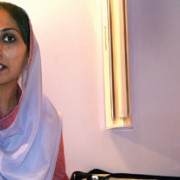

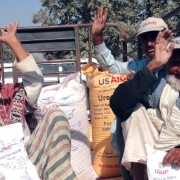
Comment
Make a general inquiry or suggest an improvement.